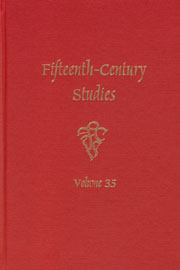Book contents
- Frontmatter
- Contents
- Preface
- Essays
- 1 Violencia en tres cuentos hagiográficos de la España medieval
- Physical Impairment in the First Surgical Handbooks Printed in Germany
- Serious Elements in Medieval French Farces: A New Dimension
- Narrative Afterlife and the Treatment of Time in Henryson's Testament of Cresseid
- Euclid in Boethius's De Consolatione Philosophiae and Some of its English Translations
- Seeking the Medieval in Shakespeare: The Order of the Garter and the Topos of Derisive Chivalry
- A Revelation of Purgatory and Chaucer's Prioress
- Eyeglasses for the Blind: Redundant Therapies in Meschinot and Villon
- Jean de Meun in the Cité des Dames: Author versus Authority
- The Festival Context of Villon's Pet au Deable: Martinmas in Late-Medieval Paris
Seeking the Medieval in Shakespeare: The Order of the Garter and the Topos of Derisive Chivalry
from Essays
Published online by Cambridge University Press: 12 September 2012
- Frontmatter
- Contents
- Preface
- Essays
- 1 Violencia en tres cuentos hagiográficos de la España medieval
- Physical Impairment in the First Surgical Handbooks Printed in Germany
- Serious Elements in Medieval French Farces: A New Dimension
- Narrative Afterlife and the Treatment of Time in Henryson's Testament of Cresseid
- Euclid in Boethius's De Consolatione Philosophiae and Some of its English Translations
- Seeking the Medieval in Shakespeare: The Order of the Garter and the Topos of Derisive Chivalry
- A Revelation of Purgatory and Chaucer's Prioress
- Eyeglasses for the Blind: Redundant Therapies in Meschinot and Villon
- Jean de Meun in the Cité des Dames: Author versus Authority
- The Festival Context of Villon's Pet au Deable: Martinmas in Late-Medieval Paris
Summary
An excerpt from John Chamberlain's Letters dated 23 August, 1599, describes the great frustration of the populace over the frivolous making of knights by Robert Devereux, Lord Essex, during his Irish campaign. Chamberlain records the following about Essex:
The Earl of Essex hath made many new knights, English and Irish, to the number of 59 in the whole since his first arrival. It is much marvelled that this humour should so possess him, that not content with his first dozens and scores, he should thus fall to huddle them up by half hundreds; and it is noted as a strange thing that a subject in the space of seven or eight years (not having been six months together in any one action) should upon so little service and small desert make more knights than are in all the realm besides; and it is doubted that if he continue this course he will shortly bring in tag and rag, cut and long tail, and so draw the order in contempt.
The complaints against Essex suggest a manifestly growing concern with the deterioration of knighthood; in fact, his mismanagement of troops abroad did much to contribute to the Order's decline. The Order of the Garter seated only twenty-four knights at any given time during the sixteenth and seventeenth centuries (even today, membership is limited to twenty-four knights – the monarch and heir apparent are ex officio members of the Garter), but Essex established more knights during the 1590s than, as Chamberlain says, “the realm desired or could maintain.”
- Type
- Chapter
- Information
- Fifteenth-Century Studies , pp. 80 - 104Publisher: Boydell & BrewerPrint publication year: 2009



